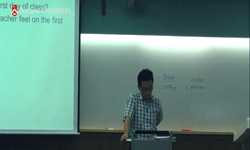This study examines the use of kulay(yo) as a response token in spontaneous Korean conversation. The data for the study include approximately five hours of Korean casual conversation and the analytic framework is conversation analysis. Based on its co...
http://chineseinput.net/에서 pinyin(병음)방식으로 중국어를 변환할 수 있습니다.
변환된 중국어를 복사하여 사용하시면 됩니다.
- 中文 을 입력하시려면 zhongwen을 입력하시고 space를누르시면됩니다.
- 北京 을 입력하시려면 beijing을 입력하시고 space를 누르시면 됩니다.
https://www.riss.kr/link?id=A76450500
- 저자
- 발행기관
- 학술지명
- 권호사항
-
발행연도
2008
-
작성언어
-
- 주제어
-
KDC
711
-
등재정보
KCI등재
-
자료형태
학술저널
- 발행기관 URL
-
수록면
217-248(32쪽)
- 제공처
-
0
상세조회 -
0
다운로드
부가정보
다국어 초록 (Multilingual Abstract)
This study examines the use of kulay(yo) as a response token in spontaneous Korean conversation. The data for the study include approximately five hours of Korean casual conversation and the analytic framework is conversation analysis. Based on its cooccurring prosody patterns, the use of kulay(yo) is divided into two types: the one with falling or continuing intonation and the other with upward intonation. The former type mainly occurs in acknowledgements, the identification and recognition sequence of phone openings, and phone preclosings and closings. The latter type is found in contexts such as informings, counterinformings, and interactionally delicate action sequences mainly as news receipts. The results show that kulay(yo) is used in various interactional contexts, reflecting how the recipient of the prior turn's talk deals with delicate actions and carefully marks his/her stance with it.
동일학술지(권/호) 다른 논문
-
- 한국사회언어학회
- 박용한(Park, Yong-han)
- 2008
- KCI등재
-
- 한국사회언어학회
- 남미혜(Nam, Mi-hye)
- 2008
- KCI등재
-
Topic and Subject in Spoken Korean Discourse
- 한국사회언어학회
- Kyu-hyun Kim
- 2008
- KCI등재
-
전남방언 남성 호칭 접미사 ‘-샌’의 용법과 방언 분화
- 한국사회언어학회
- 강희숙(Kang Huisuk)
- 2008
- KCI등재





 스콜라
스콜라


